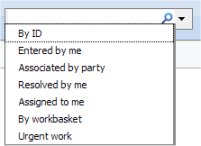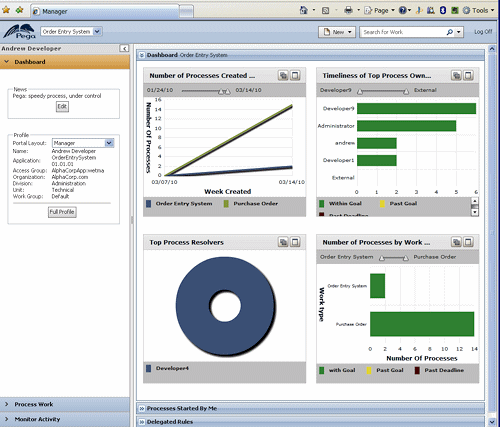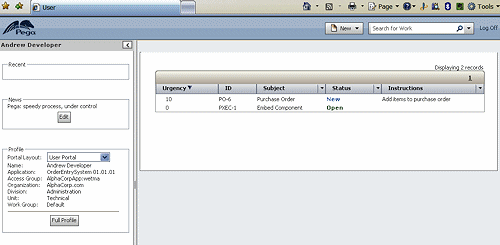|
A composite portal is a portal defined by a set of harnesses and sections. In contrast, a traditional portal is a portal defined by a fixed layout built from HTML rules.
Composite portals were introduced in V5.5. Because of their harness- and section-based structure, composite portals offer multiple advantages beyond what the traditional ('classic') portals such as the WorkManager and WorkUser portals provide. Composite portals provide:
- Full support of all styles through the Skin rule
- Greater flexibility in physical layout
- Easier development of new functions based on familiar sections and harnesses
- Ability to find work items using full-text search (not available in pyCaseManager or pyCaseWorker portals)
- Supported in Mozilla Firefox 3.6, Google Chrome 5,6 and Apple Safari 4+ as well as Microsoft Internet Explorer 7, 8 browsers
- Ability for full localization
- Automatic support of additional accessibility features
Standard composite portals for users and line managers
PRPC includes four composite portal rules for application users and managers. Each is a working example that you can copy and extend to create portals for the end users of your application.- pyCaseManager — This portal rule provides a standard user interface to support case managers. This portal is for applications developed in V6.2+. See About the Case Manager and Case Worker portals.
- pyCaseWorker — This portal rule provides a standard user interface to support users (sometimes called case workers). This portal is for applications developed in V6.2 SP2+. See About the Case Manager and Case Worker portals.
- User — Within a portal built on this example, application users can log into the application and log off, find work, enter new work, view their profiles, see recent work and work with multiple user forms.
- Manager — This portal rule is a working example that you can copy and extend to create portals for the line managers and supervisors that use your application. Within a portal built on this sample, application users can do all of the actions that can be done within the User portal plus view a process dashboard with four charts, see Monitor Activity reports, and access the worklists and workbaskets associated with a work group.
Standard composite portals for development teams
Two standard portals support business analysts, designers and developers.
- BusinessAnalyst — This special-purpose portal rule provides a standard user interface (known as the Business Analyst portal) for business analysts who work on applications.
- Developer — This special-purpose portal rule provides a standard user interface (known as the Designer Studio) for designers and developers who work on applications.
Developer, while the User and Manager portal rules have their Role field set to User. However, for many features of these portals, you can control which capabilities are available to which development team members through access roles and privileges. Common parts of composite portals (V5.5)
Common parts of composite portals (V5.5)
Those portals whose underlying portal rules have a portal role set to User can be used as working examples and starting points for you to create your own composite portals for your application's users.
Both of the working examples — the Manager and Worker portals — use the same menu bar.
The menu bar can display a control on the left, near the Pega logo, where the logged-in user can switch between his associated work pools. The user can only create new work items for the currently selected work pool.
The menu bar can provide three more controls on the right:
![]()
Click the New button to display a drop-down menu that shows all of the starter flows that the user can initiate and create a work item. Click one of the choices to start that flow and create its work item.
 The Search function appears differently in a portal depending on which option you choose for the FindWork section in your created composite portal (see the FindWork entry in the Available Standard Sections table in How to create a composite portal). For instance, the Advanced option (the default), includes the search bar and supports Lucene-based full-text search as well as work "Entered by me", "Resolved by me" and other choices.
The Search function appears differently in a portal depending on which option you choose for the FindWork section in your created composite portal (see the FindWork entry in the Available Standard Sections table in How to create a composite portal). For instance, the Advanced option (the default), includes the search bar and supports Lucene-based full-text search as well as work "Entered by me", "Resolved by me" and other choices.
The Search option provides specific and general search options for the portal's users:
- Enter a text string that relates to the sought work items, and press the enter key or click the magnifying glass icon.
- The system displays all work items that contain the specified string. Above the search results are a series of fields which can be used to refine the search:
![]()
- In the first field, the default is
All Work Types. Select to limit the search to any available work type. - In the second field, the default is
Work Objects Only. Select to search work items and Note attachments, or only Note attachments. Searching attachments is possible only if indexing of attachments is enabled in the System Settings landing page tab. Select
Searching attachments is possible only if indexing of attachments is enabled in the System Settings landing page tab. Select  > System > Settings > Search. In the Search landing page tab in the Indexing section, check the Index Attachments checkbox and click Submit. See Understanding full-text search.
> System > Settings > Search. In the Search landing page tab in the Indexing section, check the Index Attachments checkbox and click Submit. See Understanding full-text search. - In the third field, the default is
All Work. Select to limit the search to work entered by, assigned to, associated to, or resolved by the current user. - In the fourth field, the default is
Updated Anytime. Select to limit the search to one of a series of time ranges, such asYesterday.
When searching in a portal, if the user changes any of these settings, the search runs again automatically and displays revised results.
The search results display in a grid. Click the title or ID of any item to open it in a separate window for review or updating.
- Click the Log Off link to exit the portal.
Parts of the Case Manager and Case Worker portals
The user interface of the User portal is defined by the standard harness Data-Portal.User:
The left panel, from the top:
- gives the current user's name
- shows work the user has recently updated or resolved
- shows the current news broadcast. If the user has administrative privileges, an Edit button appears. The user can update the short news message for all users. See About Broadcast data instances.
- displays a summary of the current user's profile. If the user has access to multiple portals, as in the illustration, he can switch from one to another using the drop-down menu. The Full Profile button gives access to the user's profile rule.
The right panel displays the work items currently assigned to the user, in a sortable grid display. Click any work item to open it for review or work. See Using the Process Work workspace.
The user interface of the Manager portal is defined by the standard harness Data-Portal.Manager:

The left panel contains three controls that determine what appears in the rest of the screen:
- Dashboard — a series of graphs and charts, updated in near-real time, to give a high level view of project progress. See Using the Dashboard.
When the Dashboard is selected, the left panel includes- the current news broadcast. If the user has administrative privileges, an Edit button appears. The user can update the short news message for all users. See About Broadcast data instances.
- a summary of the current user's profile. If the user has access to multiple portals, as in the illustration, he can switch from one to another using the drop-down menu. The Full Profile button gives access to the user's profile rule.
- Process Work — where the administrator can create and delegate new work items, and review and resolve existing work items. See: When this gadget is displayed, the left panel contains a list of work items that the current user has recently processed.
- Monitor Activity — access to a wide range of reports on work progress and the behavior of PRPC. When this gadget is displayed, the left panel contains a series of report utilities. See Using the Report Browser.
 How to create a composite portal
How to create a composite portal
Composite portals are produced from harnesses and sections. See How to create a composite portal.

|
portal |

|
About Portal rules
About the Case Manager and Case Worker portals About Broadcast data instances |
|
|
Atlas — Standard portal rules |

 About composite portals
About composite portals

 Help Home
Help Home